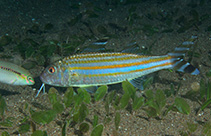
|
Upeneus vittatus (Forsskål, 1775) Yellowstriped goatfish |

|
|
photo by
Hazes, B. |
| Family: | Mullidae (Goatfishes) | |||
| Max. size: | 28 cm TL (male/unsexed) | |||
| Environment: | reef-associated; brackish; marine; depth range 5 - 100 m | |||
| Distribution: | Indo-Pacific: Persian Gulf (Ref.80050); Red Sea south to East London, South Africa and east to Micronesia and the Hawaiian, Marquesan, and Society islands, north to southern Japan, south to New Caledonia. | |||
| Diagnosis: | Dorsal spines (total): 8-8; Dorsal soft rays (total): 9-9; Anal spines: 1-1; Anal soft rays: 7-7. This species is distinguished by the following characters: D VIII,9; pectoral fins 15-16; gill rakers 7-8 + 19-21 = 27-29; lateral line scales 36-38; body depth at first dorsal fin origin 25-29% SL and at anal-fin origin 21-24% SL; caudal-peduncle depth 9.9-12% SL; maximum head depth 21-26% SL; head depth through eye 18-20% SL; head length 30-31%SL; orbit length 7.0-8.7% SL; upper jaw length 11-13% SL; barbel length 17-21% SL; caudal-fin length 26-30% SL; anal-fin height 15-16% SL; pelvic-fin length 18-21% SL; pectoral-fin length 22-24% SL; first dorsal-fin height 22-25% SL; second dorsal-fin height 14-16% SL; 7-9 total bars on caudal fin, 4-5 brown or dark brown bars on upper caudal-fin lobe, 3 (rarely 4) bars on lower lobe, increasing distally in width with the widest distal-most bar black or dark brown, while the other bars are pale brown or brown; width of largest lower caudal-fin lobe bar and/or pale interspace between distal-most bars equal to or larger than orbit; tip of lower fin lobe pale (bars on both caudal-fin lobes retained on preserved fish); tip of first dorsal-fin dark, the vertical length of the pigmented area similar in size to width of widest lower caudal-fin lobe bar; 2 yellow or pale brown mid-lateral body stripes, one from eye to caudal-fin base, where it joins the proximal upper caudal-fin lobe bar, and the other stripe below from pectoral-fin base to caudal peduncle and continued by proximal-most lower caudal fin lobe bar; 2 dorsolateral brown or pale brown stripes, with the lower one distinct and well-separated from pale body surface, extending from operculum to behind second dorsal fin, the upper one indistinct or hidden and much shorter, beginning below first dorsal-fin origin and bordered dorsally by a horizontal series of pale spots (lateral body stripes not retained on preserved fish); barbels white; white to silvery body. Dark reddish-brown dorsally, white belly, faint yellowish patches along pelvic and anal-fin bases (body pale brown in preserved fish, slightly darker above lateral line) (Ref. 83903). | |||
| Biology: | Euryhaline (Ref. 12743). Inhabits sandy lagoons and sheltered coastal waters. Also found over muddy bottoms (Ref. 5213). Benthopelagic (Ref. 58302). Often in groups (Ref. 9710). In the north-east coast of India, the male to female ratio was 1:1.5 in most months (Ref. 28761). Feeds primarily on small crustaceans. Marketed fresh (Ref. 5284). | |||
| IUCN Red List Status: | Least Concern (LC); Date assessed: 11 March 2015 Ref. (130435) | |||
| Threat to humans: | harmless | |||